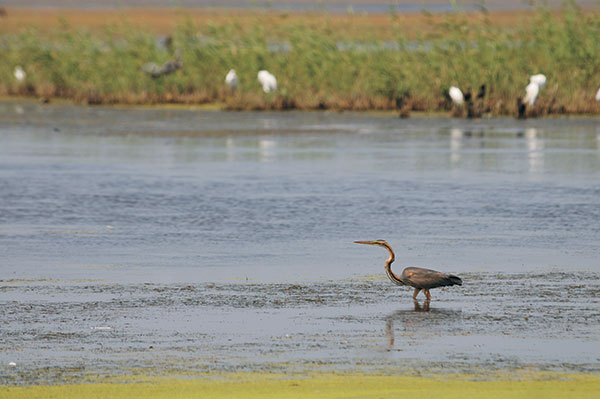Resort and recreation environments
The Caspian coastal environment is very propitious and wholesome for the recreation and health of people. This area is known for sun and long sandy beaches. All these natural resort and recreation opportunities provide convincing evidence of advantages over the famous Caucasian Black Sea coastal areas. Just for such reasons in 1983, the Cabinet of the Ministry of the Soviet Union issued a decree "On the establishment of an all-union resort basis within the Caspian Sea coastal area" in order to develop resort infrastructure within the coastal areas of Azerbaijan and Daghestan. A 680 km-long coastal area was suggested to be wholesome for resort and recreation infrastructure in Azerbaijan.  Moreover, Azerbaijan coastal area has a tremendous opportunity for tourism business development. The first tourism facilities were established in Baku already in 1958 and "Khazar" tourism camp was founded within Khudat region in 1963. Currently, Caspian coastal areas are the dominant recreation zones for the Azerbaijan people. Orchard and suburb zones are widespread along with the Caspian coastal areas, particularly within the Absheron Peninsula. At the same time, it should be noted with regret that Caspian sand beaches and mineral water springs located in this area along with the medical mud and other propitious natural resources are being used inexpedient and irrationally.
Moreover, Azerbaijan coastal area has a tremendous opportunity for tourism business development. The first tourism facilities were established in Baku already in 1958 and "Khazar" tourism camp was founded within Khudat region in 1963. Currently, Caspian coastal areas are the dominant recreation zones for the Azerbaijan people. Orchard and suburb zones are widespread along with the Caspian coastal areas, particularly within the Absheron Peninsula. At the same time, it should be noted with regret that Caspian sand beaches and mineral water springs located in this area along with the medical mud and other propitious natural resources are being used inexpedient and irrationally.
Hydrocarbon resources
The first oil borehole was drilled in the shelf area of Azerbaijan in 1920 — only 38 years after exploration of hydrocarbons was started in Pennsylvania, USA. In the middle of the 19th century, the exploration of hydrocarbon resources has started in the Caspian Sea. In 1913, the Russian Empire yielded 83% of total oil production from Azerbaijan that held first place in oil production worldwide in the 20th century. The highest level of oil production in Azerbaijan (23 M tons) was achieved in 1941. 10,000 tons of oil were produced annually within Azerbaijan offshore sector. Competent experts evaluated Caspian region hydrocarbon potential around 18-20 B tons. Proven hydrocarbon reserves are estimated as much as 10 B tons, of which 3 B tons within the Azerbaijan Caspian sector.
The region has also other mineral resources such as sow-cut-stone blocks used in civil construction, as well as gems and diversity of salt minerals.
Biological resources
 The Caspian Sea contains wealth as well as diverse and invaluable biological resources. Its diversity is represented by 1,809 species and groups. 1,069 of them live selfconsistently, 325 are parasites and 415 are vertebrates. Relic sturgeon species still reproduce themselves and constitute the world's gene pool and the major livestock, and therefore deserve particular attention. Currently, the Caspian Sea represents the inland sanctuary for all those species in the world and yields 90% of the global sturgeon production. Nowadays, the Caspian Sea holds a leading position on the following valuable freshwater species as vobla (Caspian roach) wild carp (Cyprinus carp), pike-perch. Such species as kutum, grey mullet, bream, sprat, carp, perch, Caspian sea-trout, pike are a very good nutrient product and are evaluated to be commercially valuable. All in all, 101 fish species have been listed within the Caspian Sea. The Caspian Sea has relics related to the Tertiary period Sarmatian and Pontian fauna. Caspian seals are a single mammal inhabitant of the sea.
The Caspian Sea contains wealth as well as diverse and invaluable biological resources. Its diversity is represented by 1,809 species and groups. 1,069 of them live selfconsistently, 325 are parasites and 415 are vertebrates. Relic sturgeon species still reproduce themselves and constitute the world's gene pool and the major livestock, and therefore deserve particular attention. Currently, the Caspian Sea represents the inland sanctuary for all those species in the world and yields 90% of the global sturgeon production. Nowadays, the Caspian Sea holds a leading position on the following valuable freshwater species as vobla (Caspian roach) wild carp (Cyprinus carp), pike-perch. Such species as kutum, grey mullet, bream, sprat, carp, perch, Caspian sea-trout, pike are a very good nutrient product and are evaluated to be commercially valuable. All in all, 101 fish species have been listed within the Caspian Sea. The Caspian Sea has relics related to the Tertiary period Sarmatian and Pontian fauna. Caspian seals are a single mammal inhabitant of the sea.
Sanctuaries and habitat areas
Caspian fauna includes 728 species and groups. Rivers lower watercourses and shallow offshore areas are favorable feeding ground and nesting places for waterfowl. According to the Ramsar convention, three sanctuaries were established within the Caspian coastal area for their protection: Gizilaghage in Azerbaijan, Astrakhan — in Russia, and Khazar in Turkmenistan (up to 1994 — Krasnovodsk).
Gizilaghage sanctuary is located in the far south-east of Azerbaijan, in the same gulf of the Caspian Sea, with an area of about 180 ha and was established in 1926. It is divided into large and small Gizilaghage parts. Of 101 Caspian fish species 54 species are habitant of the sanctuary. Caspian Sea-level fluctuation tremendously impacts the gulf-sanctuary hydrology, hydrochemical, and biology environmental features. The following species are typical for the sanctuary: pheasant, red goose, duck, swan, coot, diver, seagull, etc.
The Absheron Reserve was established in 2005.



